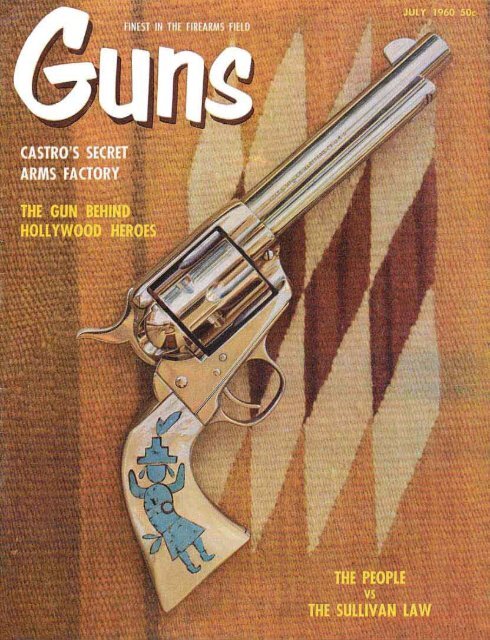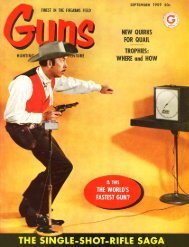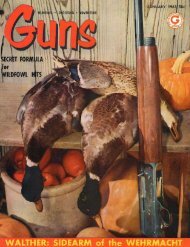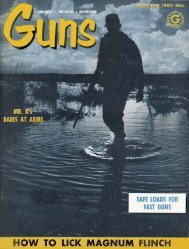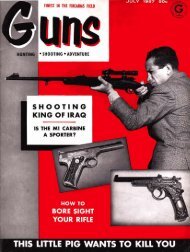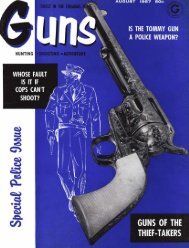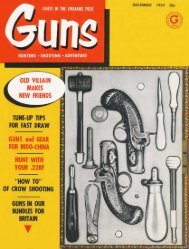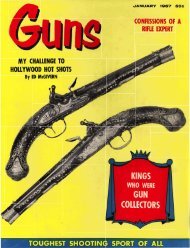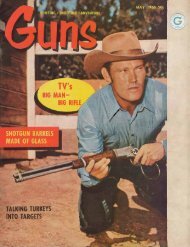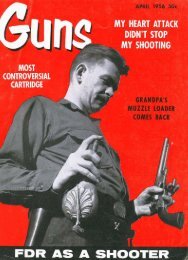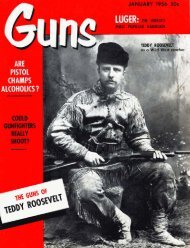You also want an ePaper? Increase the reach of your titles
YUMPU automatically turns print PDFs into web optimized ePapers that Google loves.
.22 Long Rifle or<br />
.22 Short Models'<br />
56950 56950 U.S. or Canada<br />
Prices subject to change<br />
without notice<br />
WRITE<br />
for<br />
CATALOG<br />
FITS INTO<br />
KNAPSACK OR BEDROLL<br />
BROWNING<br />
.22 Caliber Automatic<br />
Separates to a length of<br />
19 inches in 3 seconds.<br />
Weighs only 43/.1 pounds.<br />
Whether you are a scout, camper or a man who enjoys family<br />
fun on a week-end picnic, you'lI find few things so compact and convenient<br />
that promise so much sheer pleasure as the little Browning.<br />
It disassembles in seconds to a size that assures it a free ride on any<br />
expedition.<br />
And its size aids good shooting. It is designed in every detail as a<br />
smaII bore rifle. Slender lines, compact action, ideal proportion and<br />
just the right balance make for better shooting whether in the hands<br />
.ofJunior or Senior.<br />
Many safety features substantiate the thought behind its design:<br />
easier loading through a port in the stock while the gun is pointed<br />
in the safest direction - a solid steel receiver completely incasing<br />
the action - downward ejection, the harmless direction - a positive<br />
cross boIt safety ... and remember, the disassembly feature for safer<br />
storage and carrying.<br />
Of course you are interested in trouble-free performance and durability.<br />
You wiII have it with this Browning Automatic. Each part<br />
is machined from special steel and fitted by hand to the closest.<br />
tolerance. Then as a final mark of rare craftsmanship, the receiver<br />
is richly hand-engraved, the stock and forearm hand-finished and<br />
hand-checkered.<br />
..... ,<br />
The Browning is yours to shoot and enjoy for a lifetime.<br />
Come in and see the guns. You'll be convinced that Brownings<br />
aren't just made - they're created, by craftsmen.<br />
YOUR BROWNING DEALER<br />
Write for new catalog showing all Browning guns in color, plus special chapters on<br />
shootIng - practical informati'on for gun enthusiasts. .<br />
BROWNING ARMS CO. DEPT. 126, ST. LOUIS 3, MISSOURI<br />
- in CANADA: Browning ofCanada. Depl.·126, P.O. Box 991, Montreal 9. P.Q,<br />
GtJNS JULY <strong>1960</strong> 3
He's a dedicated handloader •••<br />
been loading for more years<br />
than he cares to admit. Naturally<br />
he knows his field .••<br />
knows, for example, that accuracy<br />
in bullets· depends largely<br />
on precision manufacture. That's<br />
why he likes Norma bulletsmachined<br />
by tough tungsten car·<br />
bide dies to within less than<br />
.0004 in. tolerance.<br />
He also knows that Norma's<br />
bullet design takes into account<br />
both the tremendous pressures<br />
set up by modern, high velocity<br />
loads, and the high frictions de.<br />
veloped in the gun barrel.<br />
Norma's Tri-Clad steel jacketed<br />
bullets resist deformation by high<br />
load pressures ... give all the<br />
advantages of non-fouling, friction-reducing<br />
alloys too!<br />
Follow the lead of the Norma<br />
Man. For your next loading job<br />
order Norma, world's most advanced<br />
line of-<br />
• PRECISION BULLETS<br />
• UNPRIMED VIRGIN BRASS<br />
• LOADED AMMUNITION<br />
Want more handloading info?<br />
Send for your FREE copy of<br />
"Gunbug's Guide." Box GM-7.<br />
SOUTH LANSING, NEW YORK<br />
Div. of General Sporting Goods Corp.<br />
KNOW<br />
Congressman George P. Miller<br />
Comm.: Science & Astro., Merchant Marine & Fisheries<br />
8th Dist., California<br />
I AM AGAINST the erosion of the rights guaranteed us under the Constitution. I<br />
believe the Second Amendment is as significant today as it was when the Founding<br />
Fathers wrote it... The art of using guns is one that has afforded the people of this<br />
country great satisfaction. It is the basis of a great deal of our recreation and the<br />
knowledge of firearms has proven itself valuable in time of war.<br />
Congressman Clement J. Zablocki<br />
Committee on Foreign Affairs<br />
4th District, Wisconsin<br />
WE MUST INTERPRET the provisions of the Second AmendlJ.lent in the context of<br />
the historical conditions... The Second Amendment was ... to prevent such abuses as<br />
were perpetrated during the 18th Century by the Kings of England, who disarmed the<br />
colonists and forbade them to bear arms. It was to provide the means of checking any<br />
unconstitutional usurpation of authority by the central government. Although we must<br />
remain ever watchful to prevent the usurpation of rights reserved in the Constitution<br />
to the States and to the people, it would seem to me that. during the 184 years of our<br />
nation's existence, we have developed some means more effective than muskets tl><br />
achieve those goals. While I am very mLlch interested in guns, and own guns myself.<br />
I would not be apt to encourage the bearing of arms by our citizenry as a check on the<br />
activities of the Federal government. In this instance, I believe that the voice of the<br />
people is stronger and more effective than firearms.<br />
Senator Gale W. McGee<br />
Committee on Appropriations<br />
Wyoming<br />
THE FACT THAT American citizens have enjoyed the right to bear arms throughout<br />
our history is a remarkable testimonial to the strength and stability of our democratic<br />
institutions. There are few nations where this right has been preserved so long<br />
and, where it has, it has become the symbol of responsible citizenship. The groups<br />
which cry for laws which would prevent the responsible citizen from bearing arms<br />
evidently do not realize that the danger to a society which stems from firearms is<br />
immensely increased when honest citizens are disarmed and prevented from learning<br />
enough about firearms to handle them safely.<br />
Congressman Neal Smith<br />
5th (Des Moines) Dist., Iowa<br />
THE FRAMERS of our Constitution meant to retain to the people the power tl><br />
overcome any leaders who might try to set themselves up as dictators in our country.<br />
These rights would be greatly diluted if either the military or the law enforcement<br />
branch were given a monopoly on firepower. However, there was never any intention<br />
to provide criminals, mental incompetents, or anyone with a legal right to conceal<br />
weapons. I think everyone has a constitutional right to own firearms, but that the local<br />
officials may reasonably find that the protection of other individual rights requires that<br />
no "unbroken." concealed gun be carried in populated areas.<br />
Congressman Jack Westland<br />
Comm.: Interior & Insular Affairs, Atomic Energy ..<br />
2nd Dist., Washington<br />
THIS "RIGHT of the people to keep and bear arms" is so deeply embedded in the<br />
philosophy of Americans that it's. difficult to imagine this right being challenged. Yet<br />
I know this right has been and probably will be challenged. I suppose one of the<br />
greatest days in the life of an average boy is the day when he gets his first gun.<br />
Whether it's a .22 or a BB gun, no matter, it's his and his alone. Then his dad teaches<br />
him how to handle it, the precautions he must take and the proper care of the weapon.<br />
These are great days. The subsequent "joys of hunting are things to be remembered<br />
forever. "Infringe" this right? Not me!<br />
Congressman Howard W. Robison<br />
Comm.: Public WorkS, Small Business<br />
37th (Owego) Dist., N.Y.<br />
I AM INCLINED to reel that "militia" as used in the Second Amendment connotes<br />
a civilian armed force which has now developed into the National Guard. Note alsl><br />
that the drafters of the Amendment included the words "well regulated," which implies<br />
that such an armed citizen force should be definitely controlled. This is not to say.<br />
however, that I believe further federal restrictions should be placed on the possession<br />
of firearms which are kept for sporting use or needed for personal protection.<br />
Readers' Note: All Congressmen may be addressed as "House Office Building," and all<br />
Senators as "Senate Office Building," both at "Washington 25, D. c."<br />
4 <strong>GUNS</strong> JULY <strong>1960</strong>
E. B. Mann Editor<br />
Wm. B. Edwards Technical Editor<br />
Elmer Keith Shooting Editor<br />
Kent Bellah Handloading<br />
Roslyn Wallis Editorial Ass't<br />
Sydney Barker Art Director<br />
Lew Merrell , Ass't Art Director<br />
Marvin Ginn ..... Advertising Director<br />
Lee Salberg , .Ass't Adv. Dir.<br />
Lou .Weber Advertising Sales<br />
M. Magnusson ' Classified Adv.<br />
Sanford Herzog .. Production Manager<br />
Kay Elliott..... Ass't Production Mgr.<br />
Lou Satz Circulation Manager<br />
George Tsoris Promotion Manager<br />
Editorial Advisory Board<br />
Col. George 1111. Chinn ........•..... Military<br />
Carola Mandel Skeet<br />
Stuart Miller Cartridges<br />
Val Forgett " Collectors<br />
Dee Woolem , Fast Draw<br />
Bill Toney ........•................. Police<br />
Les Field Legislation<br />
THE COVER<br />
Chrome-plated Colt ,45 single action with<br />
mother-of-pearl grips channel-worked with<br />
turquoise by Danny Simplicio of Gallup,<br />
N. M.• M.• is owned by Jim Price of Albuquer.<br />
que. The figure is.a Zuni religious symbol,<br />
is called "the Rainbow Man." A Navajo<br />
rug is used as background. The revolver<br />
carries Serial No. 175315 and a last patent<br />
date of January, 1875. Photo by Harry<br />
Kinney,. Albuquerque, New Mexico.<br />
shooting ...<br />
George E. von Rosen<br />
Publisher<br />
Arthur S. Arkush<br />
Ass't to the Publisher<br />
IN THIS ISS U E<br />
JULY. <strong>1960</strong><br />
Vol. VI, No. 7-67<br />
THE GUN BEHIND HOLLYWOOD HEROES John Lachuk 16<br />
YOU TOO CAN BE A BULLET ARTIST....... . Clyde Howell 22<br />
NEWSPAPER BACKS COPS IN WAR ON CRIME Robert V. little 27<br />
THE .264 WINCHESTER MAGNUM...................... . Elmer Keith 32<br />
special ...<br />
CASTRO'S SECRET ARMS FACTORy .<br />
legislation .<br />
THE PEOPLE vs. THE SULLIVAN LAW Robert Dyment 24<br />
guns americana . . .<br />
hunting<br />
THE MISSING LINK IN RAPID.FIRERS.<br />
THE <strong>GUNS</strong> OF THE LITTLE BIG HORN.<br />
HOW FAST CAN YOU HIT HIM?<br />
workshop . ..<br />
Robert K. Brown 19<br />
. Da niel F. Ford 26<br />
. Peyton Moncure 28<br />
....... Howard C. Sarvis 31<br />
HOW TO ACCURIZE YOUR M-I RIFLE Charles R. McClelland 36<br />
departments . . .<br />
KNOW YOUR LAWMAKERS... 4<br />
<strong>GUNS</strong> IN THE NEWS. .. 6<br />
ELMER KEITH SAYS Elmer Keith 8<br />
CROSSFIRE . . .. .. .. .. .. .. .. .. . .•. .. .. . . . . 10<br />
GUN RACK ,......... 12<br />
PULl! . .. .. .. .. .. .. . Dick Miller 14<br />
HANDLOADING BENCH . Kent Bellah 44<br />
SHOPPING WITH <strong>GUNS</strong> " , " Roslyn Wallis 58<br />
THE GUN MARKET . . . . . . . . . . . . . . . . . . . . . . . . 64<br />
INDEX OF ADVERTISERS. . . . . .. . . . . . . .. . . .. .. .. . . .. . . . . . . .. . . .. . . . . 66<br />
EDITORIAL OFFICES: E. B. Mann, W. B. Edwards, 8150 N. Central Park] Skokie, III., ORchard 5-5602<br />
Elmer Keith. Salmon. Idaho. Kent 8ellah, Saint 0, Texas.<br />
REPRESENTATIVES: NEW YORK, Eugene L. Pollock, 60 East 42nd St.• New York 17. N. Y., YUkon<br />
6-9280. MIDWEST ADV. OFFICES, 8150 N. Central Park Ave., Skokie, III., ORchard 5-6967. CALI<br />
FORNIA. The Ren Averill Co., Ren Averill. 232 N. Lab Ave., Pasadena, Calif. MUrray 1·7123.<br />
SOUTHERN, Hal Moore, 279 NE 79th St., Miami 38. Fla. PLaza 8-5516.<br />
<strong>GUNS</strong> JULY <strong>1960</strong> 5<br />
..
PRODUCED TO MEET THE DEMAND OF THE AMERICAN HANDLOADER<br />
Specifically produced to make your reloads the best<br />
regardless of your choice of reloading components.<br />
Next time give your reloads a break; once you<br />
reload CCI primers you'll immediately recognize the<br />
"built-in" precision that helps you produce un<br />
matched reloads time after time. Available at lead<br />
ing sporting goods dealers everywhere.<br />
QUALITY COSTS NO MORE WHEN YOU SHOOT eel<br />
<strong>GUNS</strong> JULY <strong>1960</strong><br />
Write to Dept. G-27 for New <strong>1960</strong> CCI Brochure<br />
cascade cartridge. Inc.<br />
BOX 282 LEWISTON. I04HO<br />
7
LOAD YOUR OWN<br />
/lhJ' RIFLE • PISTOL· SHOTGUN<br />
BETTER • FASTER • CHEAPER<br />
With Shell Holder and Primer Rod $9.50<br />
Pistol<br />
Bullet<br />
Swaging<br />
Dies<br />
Fils all i x 14<br />
Thread Tools<br />
Available<br />
in<br />
.357<br />
:429<br />
.452,<br />
1<br />
7"ee RElOA DIN G HAN DBOO K<br />
LACHMILLER ENGINEERING CO.<br />
6445 San Fernando Road, Glendale 1, California<br />
Say you saw it in Guns<br />
The Millionth Savage '99<br />
I was a guest of the Savage Arms Co. at<br />
their luncheon in the Sheraton Park Hotel<br />
in Washington, D. C., March 22nd, when they<br />
presented the National Rifle Association with<br />
their one millionth Model '99 rifle. Joseph V.<br />
Falcon, President of Savage Arms Co., made<br />
the presentation speech and Irvine C. Porter,<br />
President of the National Rifle Association,<br />
accepted. The rifle is to be placed in the<br />
N.R.A. Museum at N.R.A. headquarters in<br />
Washington.<br />
This one-millionth Savage '99 is a beauty<br />
in every respect, incorporating the new top<br />
tang safety and lever lock as well as the<br />
new Monte Carlo comb. The wood is finest<br />
figured burl walnut and the riffe is completely<br />
engraved in fine scroll and inlaid<br />
with gold in bas relief.<br />
The '99 Savage, then in .303 and .38-55<br />
calibers, figures prominently in my earliest<br />
memories of Montana elk and deer hunting.<br />
Then came the .22 Hi-Power Imp, the .250<br />
3000, and later the .300 Savage, the latter a<br />
very efficient deer cartridge. With the advent<br />
of the .308, .243, and .358 Winchester cartridges,<br />
Savage chambered their Model '99<br />
for all three; and since they introduced it in<br />
.358 caliber, it has been my chief recommendation<br />
for all who prefer lever actions as a<br />
big game rifle for America.<br />
The '99 Savage has always had' the finest<br />
magazine for a lever action rifle. That fine<br />
spool-type magazine, developed earlier than<br />
the Mannlicher Schoenauer magazine, I have<br />
always considered about the best ever pro·<br />
duced. Bullet points are not battered or deformed<br />
as is true in tubular magazines, and<br />
the Savage magazine has an indicator telling<br />
how many rounds remain in the magazine.<br />
The Savage '99 really came into its own<br />
with the introduction of the Model 99-Dl and<br />
the 99-F with their top tang safety, lever<br />
lock, and .358 Winchester caliber. The .358<br />
caliber Model '99 is a rifle I can heartily<br />
recommend for our larger game, like elk and<br />
moose and big bear, as well as for the<br />
smaller deer-sheep-goat class of game. With<br />
its 250 grain bullet in .35 caliber, it has<br />
proved a very good killer on most all our big<br />
game when properly placed. For the lady,<br />
the oldster, or anyone wanting a light, handy,<br />
fast lever action rifle for our big game, the<br />
.358 Model 99-Dl, fitted with hunting scope<br />
or good receiver sights, is a mighty good<br />
choice. It also makes one of the finest saddle<br />
guns extant, owing to total absence of projections<br />
and its flat receiver. Savage Arms<br />
Co. is to be congratulated on the production<br />
of the one-millionth rifle in this model. The<br />
serial number alone proves the '99's long-time<br />
popularity, and such popularity has to be,<br />
and is, deserved.<br />
Crossman Model 600<br />
Crossman's new semi-automatic .22 caliber<br />
pellet pistol, the Model 600 (pictured and<br />
described in detail in June <strong>GUNS</strong>), is fitted<br />
with adjustable Patridge-type !arget sights,<br />
with windage and. elevation in rear sight<br />
and a 1/IOth inch front blade. The trigger<br />
contours the trigger finger perfectly, and<br />
trigger pull is reminiscent of the finest target<br />
pistols.<br />
The new 40 ounce Crossman pistol has the<br />
weight almost directly over the crotch of the<br />
shooting hand, and it balances and points<br />
perfectly. Stock angle is just right, and this<br />
is the finest pellet·shooting understudy of our<br />
big .22 match auto pistols we have yet tested.<br />
Cheap practice with this Crossman 600 will<br />
enable anyone to take up the fine S & W,<br />
Ruger, Colt, or High Standard semi-auto target<br />
pistols and do top·flight shooting with<br />
them.<br />
The gun· is powered with C02 gas cylinders<br />
that fit in the tube directly under the<br />
barrel. Barrel is button rifled and seems very<br />
accurate. Each gas cylinder holds from 30<br />
to 40 charges, and the magazine on the left<br />
side of the gun holds ten pellets. A swinging<br />
arm picks up the pell from the magazine<br />
tube and, as· the trigger is pressed, flips it<br />
over into the barrel cone where the gas drives<br />
it forward through the barrel. It is a very<br />
ingenious arrangement and functions perfectly<br />
so long as the pellets are not damaged<br />
or out of round. T)le grips are walnut-colored<br />
plastic of excellent shape, with thumb rest<br />
for either right or left hand. Maximum range<br />
is said to be 100 feet. It buries the pellets<br />
nicely in wooden blocks at 25 feet and shoots<br />
through sardine tins, so we presume will be<br />
fine for pack rats in the cabin or knocking<br />
that wailing tom-cat off the back fe ceo<br />
Safety is just back of trigger on left side.<br />
The cocking slide is also on left side. This<br />
Crossman gas pell gun offers the best cheap<br />
indoor shooting we have seen, on account of<br />
its lack of sharp report. My tests indicate<br />
it is very accurate, and with any suitable<br />
wooden back stop it is absolutely safe to use<br />
in the yard even in a closely settled community<br />
if reasonable care is exercised. It should<br />
be a great boon to all pistol shooters who<br />
want to keep in practice without driving long<br />
distances to a pistol range. A 25 to 30 foot<br />
basement or room is all that is needed for<br />
a range, and one can learn to hold and<br />
squeeze just as well with it as with the fine<br />
target pistols and expensive ammunition.<br />
For training youngsters it is the best we<br />
have seen. However, while not a firearm, it<br />
is nevertheless a fairly powerful arm and<br />
must be treated as such. I believe it has<br />
plenty power for brain shots on cottontails<br />
(Continued on page 66)<br />
8 <strong>GUNS</strong> JULY <strong>1960</strong>
<strong>GUNS</strong><br />
Weatherby Mark V Custom .Model shown<br />
JULY <strong>1960</strong><br />
Why it is impossible<br />
to "mass produce" a<br />
Weatherby Mark V<br />
Whenever we're asked why we don't "mass produce" \Veatherby<br />
riRes and lower their cost, we invariably answer: If we did, the result<br />
wouldn't be a Weatherby!<br />
It's the extra care of skilled gunmakers ... the frequent inspections<br />
... the many hand operations ... the patient willingness to produce<br />
only the finest ... that have won for Weatherby riRes a unique place<br />
in the hearts of their owners.<br />
New hammer-forged rifling<br />
Pictured at the left is the latest Weatherby Mark V, introducing a<br />
new world's standard in rifle barrels - Hammer-Forged Rifling.<br />
\Vith this revolutionary new swaging process, the first in America,<br />
the riRing is actually "hammer forged" in the chrome steel barrel<br />
under a half-million pounds pressure. This results in a far smoother<br />
bore, greater accuracy, and longer barrel life.<br />
World's strongest action<br />
There's a feeling of extraordinary safety when using a Weatherby,<br />
both in firepower and in the riRe itself.The bolt action, acknowledged<br />
the world's safest, is capable of handling almost unbelievable pressures.<br />
Nine locking lugs, completely enclosed cartridge case, gas<br />
escape ports, streamlined enclosed cocking piece, short bolt liftthese<br />
are only a few of the advancements that make the Weatherby<br />
Mark V the safest. most powerful riRe ever developed.<br />
A sound investment<br />
Only a Weatherby offers you all these advantages for a lifetime of<br />
shooting satisfaction. Available in .257, .270, 7q1m, .300, .375, .378,<br />
and .460 Weatherby Magnums ... and standard calibers. Mark V<br />
de luxe models are priced at $265 and up, without scope. Left hand<br />
models from $295. For full details see your sporting goods dealer.<br />
The ideal scope<br />
A Weatherby Imperial Scope is the perfect companion for any fine<br />
riRe. Offers greatest light-gathering power with widest field of view.<br />
Lifetime guarantee. In 2%X, 4X, 6X. Also 2X to 7X Variable and<br />
2%X to lOX Variable. Priced from $69.50.<br />
Senti for "Tomorrow's Rifles Today" - the all-new 1961 11th<br />
edition. 140 pages of valuable information and ballistical data.<br />
Profusely illustrated. Only $2.00 postpaid.<br />
Free Literature and name of nearest dealer sent on request.<br />
BUILDER OF THE WORLD'S MOST POWERFUL RIFLES<br />
HOME OFFICE: 2791 Firestone Boulevard, South Gate, Calif.<br />
CANADIAN DISTRIBUTOR: Canadian Sauer, Ltd., 103 Church St., Toronto. Ontario. Canada<br />
EUROPEAN OFFICE: Weatherby, Inc., ]aegerhofstrasse. 29, Dusseldorf, Germany<br />
EUROPEAN DISTRIBUTOR:]. P. Sauer & Sohn. Dusseldorf, Germany<br />
9
"Extending man's vision<br />
through optical science."<br />
"
THE<br />
GUN<br />
BEHIND<br />
Many now-famous stars have learned gun skills from "first<br />
American" who has taught arms history and military lore.<br />
HOLLYWOOD HEROES<br />
I<br />
F ALL I DIAN braves had been as handy with guns as fullblooded<br />
Chickasaw Rodd Redwing, you'd never hear today's<br />
taxpayer's lament, "Give the country back to the Indians!" You<br />
wouldn't hear it, because the Indians would still be in full possession!<br />
Rodd is one of Hollywood's leading technical experts on weapons.<br />
He might very well qualify for "fastest gun alive" laurels, if he<br />
cared to claim them. But, as he puts it, "I don't, simply because I<br />
don't think there is any such thing. In the Old West, the white man<br />
had a saying, 'There was never a horse that couldn't be rode, or a<br />
man that couldn't be throwed.' This applies to fast guns. Gun-slinging<br />
is like any other skill; you can't be best all of the time. Speed with<br />
a gun depends upon the shooter's current physical and mental condition.<br />
One day, he might be unbeatable, on another, he just can't<br />
do anything right. The most any athlete can hope for is to average<br />
out as one of the best."<br />
Actually, Rodd makes his living by doing things right all of the<br />
time-at least when it counts. Too often, doing something wrong<br />
would not only cost substantial money losses for a film studio-it<br />
might cost a life.<br />
During the filming of "The Fastest Gun Alive," for which Rodd<br />
was technical director, he was obliged to shoot down a narrow<br />
corridor between dozens of extras who were "spectators" at the<br />
famous "beer mug shot" by Glenn Ford. Alan Joslyn dropped the<br />
beer mug (made of wax to avoid glass splatter), and Glenn drew<br />
and shot at it with a blank. Rodd, placed out of camera range with a<br />
.22 rifle, shattered the mug in unison with Glenn's shot. The backstop<br />
for Rodd's bullet was a bale of hay placed at the end of the narrow<br />
corridor between the extras. A wrong shot here could have been<br />
<strong>GUNS</strong> JULY <strong>1960</strong><br />
By JOHN LACHUK<br />
No phony redskin, Rodd is serious worker<br />
in local Indian crafts and social groups.<br />
17
New Angle On Old Trick<br />
Short-range accuracy plus speed is demonstrated by<br />
Redwing who draws six-gun with same hand that<br />
drops matchbox; then as box falls he cocks and fires,<br />
hitting wafer on backstop before box hits floor.<br />
disastrous, but nothing happened; and all three "takes"<br />
were perfect.<br />
Rodd is also in demand as a professional exhibition<br />
shooter. For exhibitions, he uses a pair of Frontier Colts<br />
with chambers sleeved to shoot .22 rimfire cartridges, and<br />
a pair of Marlin .22 caliber, lever-action rifles. He fires<br />
against the hardened steel backplate of a shooting board<br />
which was designed and built for him by the Los Angeles<br />
Police Department. Rodd is equally adept with his dozen<br />
Qr so big bore rifles and pistols, but they don't lend themselves<br />
to use on a stage or at a TV studio.<br />
Rodd has performed on many network TV shows, such<br />
as "Wide, Wide World," "You Asked For It," "Art Linkletter's<br />
House Party," "What's My Line," "I've Got a<br />
Secret," and "People Are Funny." During rehearsals for a<br />
recent "People Are Funny" show, Rodd twice registered<br />
draw times witnessed by 43 persons, of .17 of a second,<br />
including reaction time. On "You Asked For It," Rodd<br />
did his most controversial shooting stunt, that of throwing<br />
a knife with his right hand, then- drawing his holstered<br />
gun with the same hand and shooting a hole to receive the<br />
still hurtling knife.<br />
One Hollywood writer has intimated that Rodd's spectacular<br />
shooting is largely the result of trickery. The<br />
"trick" to the knife shot, as Rodd explained it to me, is<br />
to "Pick out a mark on the board at which to throw the<br />
knife. Then shoot a hole in that spot while the knife is<br />
in flight." It's a good trick-if you can do it.<br />
Another of Rodd's stunts is to snuff out a candle with<br />
his Frontier revolver-complicating matters by putting the<br />
candle on a swinging pendulum... pendulum... He has another pendulum<br />
with a two inch hole in its center. Through this, he<br />
splits a bullet on an ordinary hunting knife, shattering two<br />
wafers, placed one to each side of the blade. Rodd performed<br />
these and other shots in his repertoire at the<br />
December Fast Draw National Championship match, held<br />
in Las Vegas, Nevada, before an audience of over 3000.<br />
He amazed even the most blase among the shooters present<br />
to compete in the event. Crowds are nothing new to Rodd.<br />
He recently did his exhibition shooting in the Hollywood<br />
Bowl, before an audience of 20,000.<br />
Unlike many Hollywood personalities, Rodd does not<br />
make free personal appearances in search of publicity.<br />
He does perform a great many benefit shows for the Boy<br />
Scouts, Polio and Muscular Dystrophy victims, and crippled<br />
children's schools, totalling an audience in 1959 of almost<br />
8,000. He also visits boy's detention schools, in an effort<br />
to bring a message of rehabilitation to these troubled<br />
youngsters. Rodd loves childen. After Rodd performs for<br />
one of these children's groups, he throws the meeting open<br />
to questions-no holds barred. Here are a few typical<br />
ones: "When did you become an Indian?" "Do you<br />
live in a tepee?" "Are you married to a squaw?" (Rodd's<br />
charming wife, Erika, came to the United States from<br />
Germany, before World War II.) "Have you ever been<br />
shot?" "Have you ever killed anyone?" Rodd doesn't tell<br />
his youthful audience that he has taken human life, although<br />
he was obliged to do so during World War II. He<br />
does admit to being shot. When his wide eyed spectators<br />
ask how, Rodd replies with his usual impish grin, "With<br />
a B-B gun!" However, the several scars on his body really<br />
resulted from some pretty rugged action in the South<br />
Pacific as a lieutenant in the Army Air Force.<br />
Rodd's concern for his own people leads him to spend<br />
much of his time working in (Continued on page 61)<br />
18 <strong>GUNS</strong> JULY <strong>1960</strong>
<strong>GUNS</strong> foreign correspondent Brown is<br />
shown finger hold by Lt. Rafael Carrera,<br />
QM chief for Comacho, who wears<br />
2" .45 Colt New Service. Below, Brown<br />
studied, did not fire "La Siquitrilla."<br />
design, modeled after the Dominican Republic's "San<br />
Cristobal." The San Cristobal is basically a .45 caliber<br />
Beretta submachine gun. According to Comacho's more<br />
talkative aides, the armory is "fully equipped." Production<br />
capacity of the arsenal will be determined by the number of<br />
personnel employed. Comacho mentioned that production<br />
would be held up because of lack of properly trained personnel,<br />
but his aides said later that the arsenal employs 130<br />
to 140 men and, out of this group, 30 to 40 are "armorers."<br />
I was unable to get him to define what was meant by<br />
"armorers." .<br />
The equipment of the shops, bought by Batista but used<br />
only for repair work, includes forges, lathes, and punch<br />
presses capable of "24,000 presses per 24 hours." Presently,<br />
Comacho is waiting for a governmental go-ahead to<br />
start producing a .45 cal. copy of the Sten submachine gun<br />
which still is under wraps. Cuban security regulations<br />
precluded inspection of the armory.<br />
One of Comacho's experimental weapons produced in the<br />
<strong>GUNS</strong> JULY <strong>1960</strong><br />
Libertad arsenal· after being initially developed in the<br />
mountains, is the improved copy of the San Cristobal.<br />
According to Comacho its weight is slightly lighter han<br />
that of the San Cristobal; it pumps out .30 cal. carbine<br />
ammo at a faster rate than its father.<br />
Comacho has not tested its cylic rate of fire, but feels<br />
that "it shoots.40 rounds in the same time the San Cristobal<br />
would fire 30." Range is shorter than the 700-meter range<br />
of the San Cristobal due to shorter barrel length.<br />
Although I was unable to test fire the weapon, it seems<br />
logical that the modifications Comacho has introduced are<br />
definite improvements. The bolt handle is hollowed out,<br />
filled with oiled waste. The oil gradually seeps through a<br />
small aperture in the bolt handle onto the bolt itself as the<br />
weapon fires. This "oiler," according to the Comandante,<br />
rectifies one major defect of the San Cristobal, that of the<br />
bolt and extractor heating after prolonged firing which in<br />
turn caused the weapon to jam.<br />
On the San Cristobal, the (Continued on page 37)<br />
21
"BULLET ART" IS NOT A<br />
SKILL RESERVED TO TOP "PRO"<br />
EXHIBITION SHOOTERS.<br />
IT'S FUN, AND WITH PRACTICE<br />
YOU TOO CAN BE A<br />
BULLET ARTIST<br />
Old-style mailbox with new style bullet holes (above) and bullet-punched<br />
house marker are signs of author's home-developed .22 auto rifle skill.<br />
22<br />
By CLYDE HOWELL<br />
D<br />
RAWING PICTURES with bullets<br />
is a form of gun fun that has<br />
been reserved, seemingly, for the sole<br />
enj oyment of the professional exhibition<br />
shooters. Ad Topperwein was a<br />
wizard at it, could "sketch" an Indian<br />
head complete with feathered headdress<br />
almost as fast as an artist could<br />
do it with pen strokes. The late Ed<br />
McGivern referred to it as "Bullet Art."<br />
It's fun, and it requires precision shooting,<br />
and these are usually the prime<br />
requisites for popularity for a shooting<br />
sport-yet nobody does it. Why?<br />
I say nobody does it; at least I've<br />
never seen any evidences of "bullet art"<br />
in or around the homes of the many<br />
gun fans I know. Shooting friends to<br />
whom I talked knew nothing about it.<br />
Yet it isn't an expensive form of shooting.<br />
It isn't easy, yet it isn't something<br />
nobody can do but a professional<br />
gun-magician. It's visible, and will<br />
impress even your non-shooting friends<br />
-something that can't be said about<br />
the other paper-punching target games.<br />
<strong>GUNS</strong> • JULY <strong>1960</strong>
INFLEXIBILITY ON BOTH SIDES COMPLICATES ALL<br />
TALK OF GUN LAWS. BUT GUN PEOPLE ARE AT LEAST BEING HEARD<br />
"THE SULLIVAN LAW is outmoded," Governor Nelson<br />
Rockefeller's special assistant Arthur Christy told me<br />
recently in Albany. "The Governor is much interested in<br />
the problem."<br />
.Good. But New York's Governor is only the top man of<br />
many who are concerned over the Sullivan Law. Public<br />
opinion is shifting away from the old time "put more teeth<br />
into it" concept, and this is a healthy sign for the shooting<br />
sportsmen in the Empire State and elsewhere. Last February<br />
25, at an open hearing, devotees of sporting arms fired<br />
a collective volley at bills backed by New York City's administration,<br />
which would tighten controls on firearms and<br />
ammunition.<br />
The bills, drafted as part of New York City's attack on<br />
juvenile delinquency, were assailed as impeding and<br />
harassing honest men and infringing the constitutional right<br />
to bear arms. Most critical, when asked about these gun<br />
laws, was the comment of one of the nation's foremost<br />
psychologists and social workers, Dr. Lee Steiner, author<br />
of the current best-selling "Understanding Juvenile Delin-<br />
quency" which all but ignores the anti-gun law.<br />
"These anti-gun laws as supposed cures for juvenile delinquency<br />
seem often to be the work of desperate people<br />
willing to take any measure," Mrs. Steiner said. "They<br />
appear not to be really concerned over whether their ideas<br />
will work, or not.<br />
"You will recall that National Prohibition was much the<br />
same thing and it, too," Mrs. Steiner dryly commented,<br />
"was supposed to cure all sorts of social evils."<br />
Thirty firearms bills, including shotguns and rifles, were<br />
taken up at the hearing. Spokesmen for rod and gun clubs<br />
found no merit in any of the restrictive legislation. They<br />
sympathized with police problems, but declared that more<br />
legislation was not the answer. .<br />
Karl T. Frederick, who spoke for the State Conservation<br />
Council, declared that New York already had the strictest<br />
laws on firearms, yet still has a high crime rate.<br />
"It's not the weapons," he said, "but the people that use<br />
them. This notion that crime can be stopped by passing<br />
another bill is utterly fatuous." (Continued on page 49)<br />
THE SULLIVAN LAW<br />
<strong>GUNS</strong> JULY <strong>1960</strong> 25
The Missing Link • The Missing Link In Rapid-Firers<br />
• In Rapid-Firers<br />
Primitive rapid fire gun found in old stone house pre-dates Civil<br />
War but has design of Luger, Maxim and Borchardt! Steel reload<br />
shells were charged, capped before placing into gun feed trough.<br />
Shells in feed tray roll onto spindle. putting<br />
each shot in line with the moving breech bolt.<br />
By DANIEL F. FORD<br />
H<br />
ISTORIANS<br />
USUALLY credit R. J. Gatling with producing the<br />
first practical machine gun for combat use. Practical, his guns<br />
were, and combat use they saw, but Gatling was not the first. The<br />
Gatling system was the highest expression of the '.'battery g1]!1," a<br />
repeater with a group or battery of barrels. But for nearly a century<br />
now the single-barrel gun has held the field, and the most widely<br />
used single barrel gun was the Maxim'.<br />
As machine gun students know, the Maxim's construction centers<br />
around a Luger-like toggle joint action which imparts a fore-andaft<br />
movement to the breech block to fire and reload. The Maxim was,<br />
Sir Hiram Maxim supposed, an "improvement" on the Gatling. But a<br />
recent discovery in New Hampshire may show the basic design of the<br />
Maxim, though not Maxim's, pre-dates the Gatling by a handful of<br />
years. A local gunsmith has unearthed a percussion-cap machine gun<br />
which residents conjecture may date so far back as 1840, decades<br />
before either Gatling or Maxim made their appearance. The gun,<br />
located in the village of Charlestown, fires .54 caliber rifle bullets<br />
through a single barrel as fast a.s the operator can turn the crank. A<br />
slight alteration in the mechanism, a spring to automatically return<br />
the breech block, would have produced a true automatic machine gun<br />
had the inventor wanted it!<br />
In the opinion of Col. George M. Chinn, (Continued on page 62).<br />
26 <strong>GUNS</strong> JULY <strong>1960</strong>
Total of 481 officers registered<br />
at Bergen shoot from 53 bureaus.<br />
W. H. Harrington, Englewood, aims<br />
Colt OMT that took first place.<br />
S&Ws on the line jump at Fair<br />
Lawn range during police match.<br />
Many departments issue targetsighted<br />
guns, encourge practice.<br />
NEWSPAPER BACKS COPS<br />
IN WAR ON CRIME<br />
JERSEY NEWSPAPER BOOSTS SHOOT. POSTS NAMES.<br />
SCORES. AS COPS PRACTICE GUN' SKILL THAT<br />
By ROBERT V. LITTLE<br />
WILL DISCOURAGE CRIMINALS<br />
J<br />
UNE 9, 1956 ... A POLICEMAN lined up the sights of his .38 special and<br />
fired. He flinched from the noise and recoil of his own weapon, and the<br />
sound of the shooting going on around him. Desperately he tried to steady his<br />
shaking hand and fire again before it was too late! Minutes later-when it was<br />
all over-he shook his head in despair as he talked to the cop next to him. "I<br />
was shaking like a leaf! How about you?"<br />
The other cop grinned self-consciously as he answered, "I was scared stiff!"<br />
What nerve-shattering ordeal had these two policemen just been through?<br />
-a gun battle with a notorious criminal? A fight to the death? No, they had<br />
just completed their relays in a pistol match and were discussing their<br />
performance behind the firing line.<br />
Was this dismal lack of poise a sad commentary on the protectors of our<br />
citizenry? If so, a lot of civilian shooters would sympathize, for match pressure<br />
gets us all. At any rate, it was encouraging to see two policemen, even if not "hot<br />
shooters," at least firing their guns ... shooting man to man in a pistol match<br />
alongside that select few who seem to make up the (Continued on page 40)<br />
<strong>GUNS</strong> JULY <strong>1960</strong> 27
BID lOIN<br />
<strong>GUNS</strong> JULY <strong>1960</strong><br />
Boy general never grew up; ended starred career with<br />
blunder so big historians still split on reasons why.<br />
Custer battle museum preserves relic M76 Winchester found on site but made too late. Colt Peacemakers<br />
under 10,000, Springfield carbines under 45,000, may be Custer relics. Genuine guns are rare.<br />
29
outed and put under siege atop<br />
what is now known as Reno Hill,<br />
four miles from the actual Custer<br />
battlefield. Total killed in entire<br />
command: 315.)<br />
There were many factors besides<br />
weapons contributing to the<br />
disaster'at the Battle of the Little<br />
Big Horn. (1) Enmity and jealousy<br />
existed in the entire command,<br />
composed of Custer and<br />
anti-Custer advocates. (2) Forced<br />
marching from the time the command<br />
left the Yellowstone, especially<br />
during the last night before<br />
the battle, must have had<br />
some adverse effect on the troops'<br />
fitness and endurance. (3) There<br />
were many raw and inexperienced<br />
recruits in Reno's battalion.<br />
(4) Custer underestimated and under-rated the Indians'<br />
strength and abilities as fighters. (5) Custer jumped the<br />
gun by one day and attacked without waiting for Gibbons'<br />
forces to join him as was previously agreed. (6) The location<br />
of the site of the battle was unfavorable to cavalry<br />
tactics. " The list could be extended, with every point<br />
argued pro and con.<br />
Another thing I have heard mentioned, was the presence<br />
of liquor just before and during the march up Rosebud<br />
Creek just preceding the Battle. Whiskey is referred to in<br />
Charles Kuhlman's exceptionally complete book, "Legend<br />
Into History." Several years ago I saw a printed circular<br />
tacked to a Lame Deer store in which some public official<br />
recounted that a sizeable quantity of "snake bite remedy"<br />
had been taken along and that there was drunkenness during<br />
the march. Who knows?<br />
But, still, there was that factor of weapons. And that must<br />
have had some bearing on the disaster, although how much<br />
weapons handling outweighed bad generalship, it is difficult<br />
30<br />
Among finest of cased Navy Colts in<br />
famous Chernoff Collection, Chicago,<br />
are French-cased pistols from Stokes<br />
Kirk sale. They were once documented<br />
as owned by Custer who left them home.<br />
Indians had motley array of arms. Bows<br />
and arrows took biggest toll of 7th<br />
troopers. Sharps Octagon Sporting<br />
Rifle in museum was fired by Spotted<br />
Wolf, Cheyenne, in Custer battle. The<br />
1866 Winchester was found on scene by<br />
Two Whistles, Crow scout with Gibbons.<br />
Soldiers lacked not guns, but numbers.<br />
now to tell. Custer's blunders were bad enough.<br />
Each soldier was armed with a Model 1873 Springfield<br />
carbine, of .45-70 caliber and a Model 1873 Colt Army<br />
revolver (the Peacemaker) also of .45 caliber. The carbines<br />
were manufactured in the Government arsenal at Springfield,<br />
Mass. The revolvers were purchased, on a contract<br />
basis, from the Colt firm at $13 and $12.50 each. The revolver<br />
was of the single action type, with a six shot cylinder<br />
capacity. The carbine was a single shot arm with an accurate<br />
range, in experienced hands, of about 400 yards.<br />
While a number of the 1873 carbines have turned up at<br />
the Custer Battlefield museum through the years, not all of<br />
these were used at the Custer Battle; nor indeed could they<br />
have been since the serial numbers of some were too high<br />
and because of certain refinements added later, such as<br />
aperture butt plate (for a cleaning rod) and modification<br />
of the rear sight. As a general guide, one may assume that<br />
1873 Springfield carbines with serial numbers up to 45,000<br />
may have legitimate claim to (Continued on page 42)<br />
<strong>GUNS</strong><br />
JULY <strong>1960</strong>
By ELMER KEITH<br />
T<br />
HE LONG-AWAITED Model 70 Winchester in .264 Magnum<br />
caliber is now a reality, ready and waiting for the <strong>1960</strong> hunting<br />
seasons. The new cartridge is based on the same blank as is used<br />
in the .458 African and .338 Alaskan, and is to be called "The<br />
Westerner." It comes in two bullet weights: a flat-based 100 grain at<br />
3700 feet velocity, and a 140 grain at 3200 feet. Naturally, I much<br />
prefer the 140 grain bullet for all shooting over long ranges, for either<br />
pests or the lighter big game.<br />
Winchester advertises this rifle and cartridge for elk as well as for<br />
the smaller big game. On this, as a big-bullet man, I cannot agree. It<br />
should take all our lighter big game nicely, including the small barren<br />
ground caribou; but I would not choose it for elk, moose, or big bear.<br />
The rifle is cut with a nine inch twist and the Winchester engineers<br />
tell me that the 140 grain bullet was the heaviest that would stabilize. I<br />
would have preferred a 7%" to 8" twist and a 160 grain bullet. But<br />
this doesn't mean that I don't like this rifle; I do. It should just about<br />
fit the dreams of any man for a long range, flat shooting rifle; and its<br />
ballistics are close to amazing.<br />
The cartridge case is huge for the bore for most all I.M.R. powders,<br />
and Winchester loads it with a special ball powder of very slow-burning<br />
characteristics. Hodgson's 4831 will work in the new cartridge,<br />
and an even slower burning powder would no doubt be advisable.<br />
We received rifle No. 465286 for test. Action and trigger of this<br />
rifle was rough, but it has a very fine barrel. We fitted it with a<br />
Bushnell 3X-9 variable-power scope with command post and crosshair<br />
reticle in Bushnell Model 70 mounts. The scope and mount<br />
performed perfectly on this rifle. In fact, it seems an ideal combination<br />
for such a high veloCity, flat shooting, long range rifle.<br />
The rifle is slim, trim with a three-shot magazine. Barrel length is<br />
26", necessary to burn the huge charge of slow-burning ball powder<br />
properly. Stock is Monte Carlo comb, type P.G., just right for scope<br />
use but a bit tight for the folding leaf rear sight. However, that<br />
folding rear sight in conjunction with a fine hunting scope is ideal<br />
for this rifle, or most any hunting rifle. Should the scope be damaged<br />
or put out of commission, the rifleman still has a good set of open<br />
Unfired<br />
100 yd.<br />
range<br />
200 yd.<br />
range .<br />
•<br />
tt<br />
300 yd.<br />
range<br />
400 yd.<br />
range<br />
tl I<br />
500 yd.<br />
range<br />
New "Power Point" bullet of .264 is major<br />
partner of development. Expansion of two<br />
good bullets, 100 and 140 gr. are shown.<br />
The .264 Winchester MagnuJJl<br />
PEOPLE FORGET THAT KEITH. ADVOCATE OF<br />
BIG CALIBERS. WAS ALSO "IN ON" THE DEVELOPMENT 0 F MANY HIGH<br />
VELOCITY LOADS. HERE IS ONE HE LIKES<br />
32 <strong>GUNS</strong> JULY <strong>1960</strong>
How To Accurize Your<br />
By CHARLES R. McCLELLAND<br />
N<br />
ow THAT UNCLE SAM's SAM's World World<br />
War II rifle is being released in<br />
ever increasing quantities, there will<br />
be many questions raised by the proud<br />
new owners of U.S. caliber .30 M-l<br />
;ifles when they find that the groups<br />
they fire are not as tight as they would<br />
like.<br />
Most of the M-l's 'generally available<br />
today are run of the mill, rapidly produced<br />
brutes that will keep up with<br />
or surpass any other similar military<br />
weapon in the world, but which will<br />
not produce match' results-not, at<br />
Guard meets resistance '/2" or less<br />
closing, affects bedding pressure.<br />
least, without a little tuning. Therefore,<br />
unless you are one of the more fortunate,<br />
able and willing to sweeten Uncle<br />
Sam's coffers by about $170 by purchasing<br />
a National Match model M-l<br />
through the Director of Civilian Marksmanship,<br />
you will probably have to be<br />
content with one of the standard models<br />
now available through many outlets.<br />
The standard model in new condition<br />
sells for about $100; less commercially.<br />
The standard model can be made to<br />
perform practically as well as the<br />
match model by applying a few tried<br />
Receiver needs a<br />
clearance forward<br />
of rear curve. On<br />
handguard ends,<br />
leave 1/32" for<br />
heat to expand.<br />
and proven gimmicks. Anyone who can<br />
use a sharp Boy Scout knife should be<br />
adept enough to do most of the suggested<br />
alterations; alterations that are,<br />
by the way, essentially the same as the<br />
accurizing methods employed at the<br />
Springfield Armory in the production<br />
of the National Match Model. If you<br />
do run into problems you can't handle,<br />
consult your local gunsmith.<br />
The primary difference between the<br />
Standard model that is issued to the<br />
G.I.'s and the National Match version<br />
is in the barrel. Tolerances for the<br />
match barrel are held close to those of<br />
commercial target barrels. whereas the<br />
standard barrels are made a little looser<br />
to avoid malfunctions in combat. Let's<br />
not go into more technical comparison<br />
of the two barrels; suffice it to say that<br />
the match barrel is more accurate due<br />
to greater coddling during manufacture.<br />
This is what you would have paid<br />
for with that extra $70, and it's a condition<br />
you can't alter with a jackknife.<br />
From a safety standpoint, however,<br />
both barrels, as well as the action,<br />
are said to be as strong as any manufactured<br />
today.<br />
For accuracy's sake, let us look at<br />
some of the exterior features of the M·l<br />
that will often more than offset the<br />
quality of the barrel. Barrels expand<br />
and get longer when they are heated<br />
through firing. This expansion, if impeded<br />
in any way, will cause the barrel<br />
to bend ever so slightly, but enough to<br />
throw the bullets far from a tight group<br />
on the target.<br />
Generally, this normal expansion will<br />
be hampered by either the handguards<br />
or the rear loop of the gas cylinder<br />
fitting too tightly. This will usually r(sult<br />
in vertical stringing of bullet impacts.<br />
To cor- (Continued. on page 39)<br />
Action beds where<br />
arrows point. You<br />
may relieve and<br />
pack cuts with a<br />
glass bedding to<br />
improve shooting.<br />
36 <strong>GUNS</strong> JULY <strong>1960</strong>
BANNERMAN'S<br />
BOX 26, BLUE POINT, L.I., N. Y.<br />
BOX 26, BLUE POINT, L.I., N. Y.<br />
CW Cloth Haversack $2.75<br />
CW Knapsack 2.00<br />
CW Carbine Sling<br />
w/Swivel 10.00<br />
CW Rifle Sling 2.00<br />
CW CSA Buckle, Square,<br />
Replica .m 2.50<br />
CW CS, Oval Buckle,<br />
Replica 2.75<br />
CW CS, 2pc Buckle, Replica 2.50<br />
CW Eagle Buckle, Replica 2.50<br />
CW Round Eagle Plate,<br />
Replica h<br />
...........hm........ 2.75<br />
CW .58 Cal. Spr. Bayonet.. 3.00<br />
CW Cannon Worm 5.00<br />
CW Cannon Rammer 7.00<br />
1842 Bayonet .. 2.00<br />
1822 Bayonet 2.50<br />
45-70 Bayonet & Scab 3.50<br />
45-70 Ber Belt & Buckle 3.50<br />
45-70 Ctg. Box h........... 1.50<br />
45-70 Rifle Sling 2.00<br />
45-70 Wrench 50<br />
45-70 Manual, Orig 3.00<br />
Spr. Shoulder Arms<br />
by Fuller 7.50<br />
1863 Manual, Reprint _.. 1.50<br />
CW Navy Boarding Pike<br />
Head 3.00<br />
45-70 Carbine Sling<br />
w/Snap Hook .m 5.00<br />
Sharps Carbine Ctg. Box 2.00<br />
CW Cannon Ball, 3" 5.00<br />
Leather Gauntlets, Old Issue,<br />
Need Stitching, Pro 5.00<br />
Cloth Epaulettes, Green<br />
w/Yellow Trim, Pro ........ 5.00<br />
Prices do not include postage.<br />
Bannerman catalog, 7955 edition,<br />
$3.00 postpaid<br />
BANNERMAN'S SONS, Inc.<br />
Box 26, Blue Point, L. I., N. Y.<br />
NOW IN PRINT<br />
322 Poges-156 Full Poge Illustrations<br />
The complete encyclopedia on the<br />
famous Luger. Chapters of interest<br />
to the collector, shooter. gunsmith.<br />
and "gun nut." Over 85 major varia.<br />
tions are ca eel ••• each with<br />
a full page and a full<br />
accurate<br />
.303 British Loads<br />
T<br />
HE SUN NEVER SETS on guns cham·<br />
bered for the .303 British cartridge.<br />
They are widely used to bag everything. It<br />
did very well in the hands of ivory poachers<br />
in darkest Africa if you count up the tons<br />
of ivory they collected. But, of course, that<br />
doesn't .mean it's an elephant rifle.<br />
The .303 British is much like our .30·40<br />
Krag. Safe charges for our outrigger maga·<br />
zine piece can be used in the British number<br />
with bullets of equal weight and design.<br />
Shiploads of surplus .303's are in this<br />
country. Those in good condition are suitable<br />
for any game that a .30·40 Krag will bag.<br />
Scope mounting is 'not a do·it·yourself job<br />
on any of the Enfield 1914 actions, but gun·<br />
smiths make altera'tions so they take Buehler,<br />
Williams, and other mounts. The "Reming·<br />
ton 30" type of conversion is most popular.<br />
For the SMLE's, Williams makes good sights<br />
and mounts.<br />
The .303 is called a "bastard .30" because<br />
generally .311" bullets are used rather than<br />
.308". Groove diameters may vary quite a bit<br />
One-piece stock is specialty of EI·<br />
wood Epps, Clinton, Ont., on S.M.l.E.<br />
Williams mounts are popular on .303s.<br />
from the listed .311". Winchester and Rem·<br />
ington both supply loads with a 215 grain<br />
bullet starting at 2180 feet per second. I<br />
think lighter pills are better for most use,<br />
and certainly for deer·size game in open<br />
country. Larger game might require heavy<br />
slugs for deep penetration at low velocity,<br />
and you do get it with a .303.<br />
Handloaders may have some difficulty un·<br />
less the conect diameter bullet is used. If<br />
you can't slug and mike your bore, your<br />
gunsmith will do it. I've never seen a tight<br />
bore, but a friend has one that shoots .308<br />
bullets with good accuracy. Some writers of<br />
yesteryear recommended 8mm bullets. The<br />
.303 is also a "bastard 8mm" because .323"<br />
pills are too large for the bores I've seen.<br />
Loaded ammo sometimes. fails to chamber<br />
and, if it does, ·pressure will definitely<br />
increase.<br />
Some 8mm bullets are only .318". They<br />
can be used with loads carefully worked up<br />
for oversize bores. I do not consider them<br />
correct for barrels with grooves near .311"<br />
or .312", as measured by someone who knows<br />
how to slug and mike a bore with a quality<br />
mike.<br />
If you happen to have a supply of 8mm<br />
bullets, and must use them in a bore of<br />
unknown dimensions, and the cartridges<br />
chamber freely, at least start with powder<br />
charges fully 10 per cent lighter than<br />
"standard" and work up, provided extraction<br />
is easy and you have no indications of exces·<br />
sive pressure. This statement is not for you<br />
old hands who are skilled in loading am·<br />
munition, but for beginners seeking infoI"<br />
mation. Working up charges with your par·<br />
ticular components and gun is basic, and<br />
applies to most all calibers of rifles. Check<br />
out your 8mm pills by dropping one in the<br />
mouth of a fired factory case of the make<br />
and lot number you plan to reload. If it<br />
doesn't drop in freely the bullet is probably<br />
too large for your chamber.<br />
This trick doesn't tell you anything about<br />
the bore. But a tight throat can raise pres·<br />
sure fast, and the increase is at the worst<br />
possible place. Thrust is increased on the<br />
vital case head and in the chamber. I like<br />
bullets fairly close to groove diameter in<br />
most rifles. This nearly always allows the<br />
necessary couple of thousandths or more<br />
clearance in the vital throat area. Tight<br />
throats (or oversize bullets) cause high pres·<br />
sure and poor accuracy. ExtreI)1ely sloppy<br />
throats give poor accuracy. Military arms<br />
often have slightly sloppy throats, but seldom<br />
tight ones.<br />
Brass thickness of the .303 British case<br />
varies quite a bit. Norma wisely supplies<br />
loads with 130 grain bullets starting at 2790<br />
feet per second. These are real little hellers,<br />
using some 42.4 grains of Norma 101 powder<br />
with breech pressure only 39,910 pounds per<br />
square inch. You get the same ballistics with<br />
38 grain DuPont 4198, but pressure jumps<br />
over 3,000 psi. It's still well within the<br />
maximum recommended 45,000 psi limit.<br />
Norma's 180 grain boat tail bullet starts<br />
at 2410 f.p.s., using 39 grains of their 101,<br />
or 38.3 grains of DuPont 3031. Norma am·<br />
munition is excellent, and the above are<br />
both good loads. I recommend cutting the<br />
listed charges a grain or so for reloads.<br />
The 215 grain Norma slug starts at the<br />
same 2180 f.p.s. as U. S. ammo, using 37.5<br />
grains of their 101 powder, or 37.7 grains<br />
of our 4064 that gives a little lower pressure<br />
than the Swedish propellant. All Norma<br />
bullets are .311", and of the four diameters<br />
44 <strong>GUNS</strong> JULY <strong>1960</strong>
"<br />
WITH<br />
HANDY CARVE BILLFOLD KIT designed<br />
for do-it-yourselfers. Made with Handy Carve<br />
tool. Complete kit contains pre-cut billfold<br />
parts of quality natural leather, genuine<br />
leather lacing, lacing needle, pattern, instructions,<br />
leather finish; plus Handy Carve<br />
tool of durable stainless steel with easy-grip<br />
rubber handle. Pride of any sportsman.<br />
Priced at $2.95 ppd., from Tandy Leather<br />
Co., 300 Throckmorton, P. O. Box 791, Fort<br />
Worth, Texas.<br />
BULLET SWAGING DIES for %" x 14<br />
thread tools, produces jacketed high velocity<br />
bullets in one operation-right to size and<br />
shape. Ready to load. Made to 2/10,000 of an<br />
inch tolerance. Available in .357, .429 and<br />
.452 diameter. All in semi-wad cutter shape.<br />
Weight of bullets can be changed simply by<br />
changing length of lead wire slug. Core of<br />
bullet is soft lead wire for perfect swaging<br />
and perfect expansion on game. A product of<br />
Lachmiller Engineering Co., 6445 San<br />
Fernando Road, Glendale 1, Calif.<br />
POCKET SAW for sportsmen can be carried<br />
in vest pocket. Consists of two ring grips at<br />
the ends of a 20-inch length of jagged steel<br />
wire. Miniature chain saw capable of big<br />
things. Easily cuts firewood. Weighs V2<br />
ounce, sells for 98c, ppd. From: The Gokey<br />
Co., 94 E. 4th St., St. Paull, Minn.<br />
ANDEROL RUST PREVENTIVE for guns<br />
available in 3-ounce spray container. Spray<br />
application provides continuous light film<br />
protection not necessary to remove for firing.<br />
Can be used for guns in storage, on display,<br />
or in use. Gives positive protection from rust<br />
or salt spray corrosion for guns, parts await-<br />
ing repair, barrels after blueing or being<br />
turned, spare parts, dies and tools. Available<br />
in sporting goods stores for $1.00. 16-ounce<br />
can for gunsmiths and collectors retails for<br />
$2.25. Manufactured by Lehigh Chemical Co.,<br />
Chestertown, Md. Additional information<br />
from Consumer Products Div., Anderol,<br />
Chestertown, Md,<br />
SPORTSMAN'S SHEAR. 8-inch shear with.<br />
one blade serrated with teeth slanting backward<br />
for strong grip. Fine tool for cutting up<br />
fowl, scaling, removing fins, cleaning fish.<br />
Has vital gadgets: bottle opener, cap remover,<br />
screwdriver, hammer, wrench, and<br />
nutcracker. Priced at $3.25, ppd. From: The<br />
Gokey Co., 94 E. 4th St., St. Paull, Minn.<br />
GUN CLEANING KIT being marketed nationally<br />
by Erwin Weller Co., Sioux City,<br />
Iowa. Available for all popular shotgun<br />
gauges; deluxe kit includes duraluminum<br />
rod, generous-size bottles of gun oil and solvent,<br />
several seasons' supply cloth patches,<br />
yarn swab, and wire brush, Kit packed in<br />
sturdy metal-bound fiber box, priced at low<br />
$3.00.<br />
POWD·R·HORN transfers powder from scale<br />
to case in one easy operation. Unit consists<br />
of plastic scale pan and c.ompensator weight<br />
for use with most popular powder scales.<br />
Scale pan incorporates a pouring funnel so<br />
that weighed charges can be transferred directly<br />
to cartridge case. Make of scale should<br />
be specified when ordering. Priced at $2.00<br />
ppd. from Powd-R-Horn Co., P. O. Box<br />
11322-G, Phoenix, Ariz.<br />
DEVCON STEEL, filling and sealing prod·<br />
uct ideal repair for chipped metal and wood<br />
firearm parts. Applied right from tube, it<br />
hardens to steel-like mass in two hours without<br />
heat or pressure. Can be used by do-ityourself<br />
sportsmen for welding handles on<br />
camping utensils, filling in chipped areas on<br />
coolers and stoves or dents in the car, and<br />
bonding metals, plastics, glass, wood, porcelain,<br />
and enamel to themselves or each other.<br />
Devcon Steel takes on copper, brass, silver<br />
or bronze finish by rubbing with appropriate<br />
metal. Produced by Devcon Corp., Danvers,<br />
Mass.<br />
PORTABLE LANTERN. Outdoorsman's 12volt<br />
Radar·Lite portable lantern produces<br />
brilliant 80,000 candlepower beam. Gives<br />
nearly a full mile visibility and will deliver<br />
up to three times the life of other 12-volt<br />
battery-operated lights. Uses exclusive Switch<br />
Lock. Radar-Lite, priced at $10.95, manufactured<br />
by Burgess Battery Co., Freeport, III.<br />
<strong>GUNS</strong> JULY <strong>1960</strong> 59


